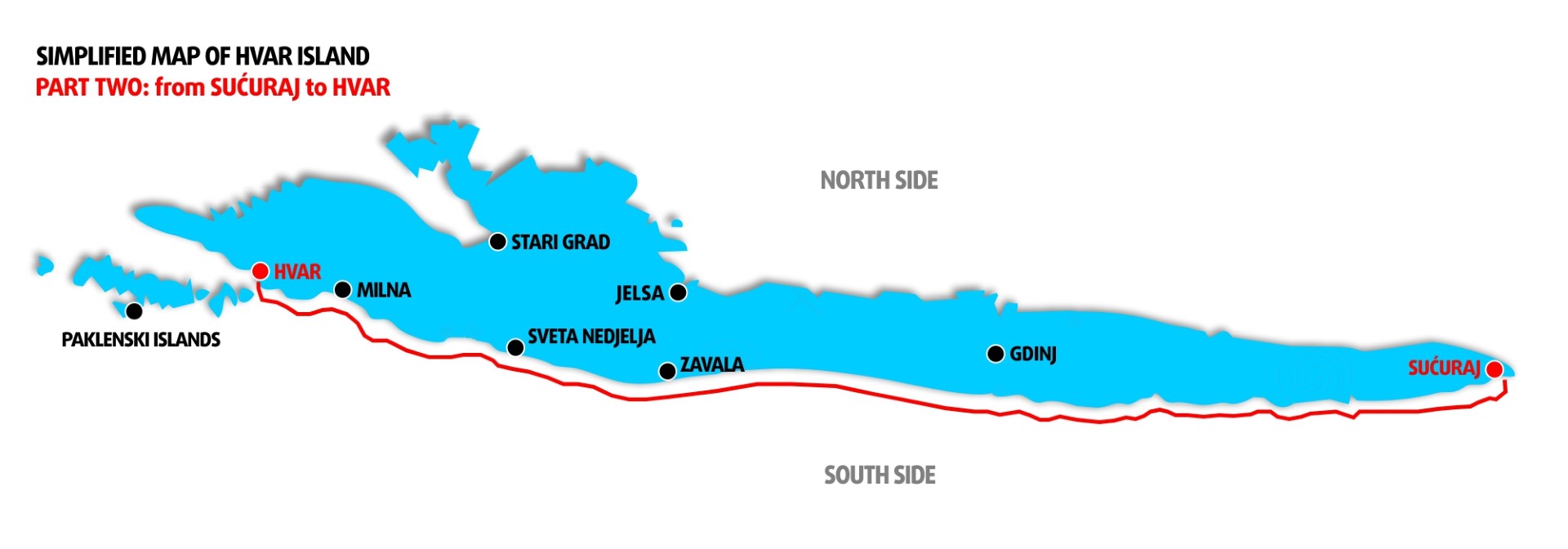Exploring every bay of Hvar island by sea kayak
Part 2: From Sućuraj to Hvar
Click here to read Part 1: From Jelsa to Sućuraj
We continue exploring every bay of Hvar island by sea kayak on our second day. Parts of the south side are very familiar to us, more and more familiar as we come closer to Hvar town. South side is, by many, considered to be more representative of what Hvar island is all about, so with the fresh knowledge from the north, it could be said that we had high expectations and our expectations were met!
After a short break for coffee and re-supplying, we said goodbye to Sućuraj – a small picturesque fisherman’s town, and the most eastern settlement port on the island of Hvar. It is also nearest to the mainland. As it is far away from our sea kayak base in Hvar, we have definitely enjoyed the experience of kayaking in its bay.
One almost surreal scene as we were exiting Sućuraj: large excavator doing its share in a reconstruction of the port seemed like it was floating while standing on a submerged ground.
PART 2: FROM SUĆURAJ TO HVAR
Leg length: 69km / 37nmi
Number of bays: 80
Česminica is a large, open bay and a beach just around the corner. Being a part of Sućuraj, we can guess this beach is a popular place for the locals and their guests.
Blaca still feels like a part of Sućuraj, with lots of residences along the rocky coast and lots of man-made sunbathing spots.
Perna looks great on a map, and in-person! There are no summer residences, just one pretty large beach with lots of green and shade around. And soil. Looks like it is peaceful even in the busiest part of summer.
Prapratna is similar to Perna, just a little bit rockier.
Zidigova is confusingly similar to Perna and Prapratna, just double in size. No signs of human interference.
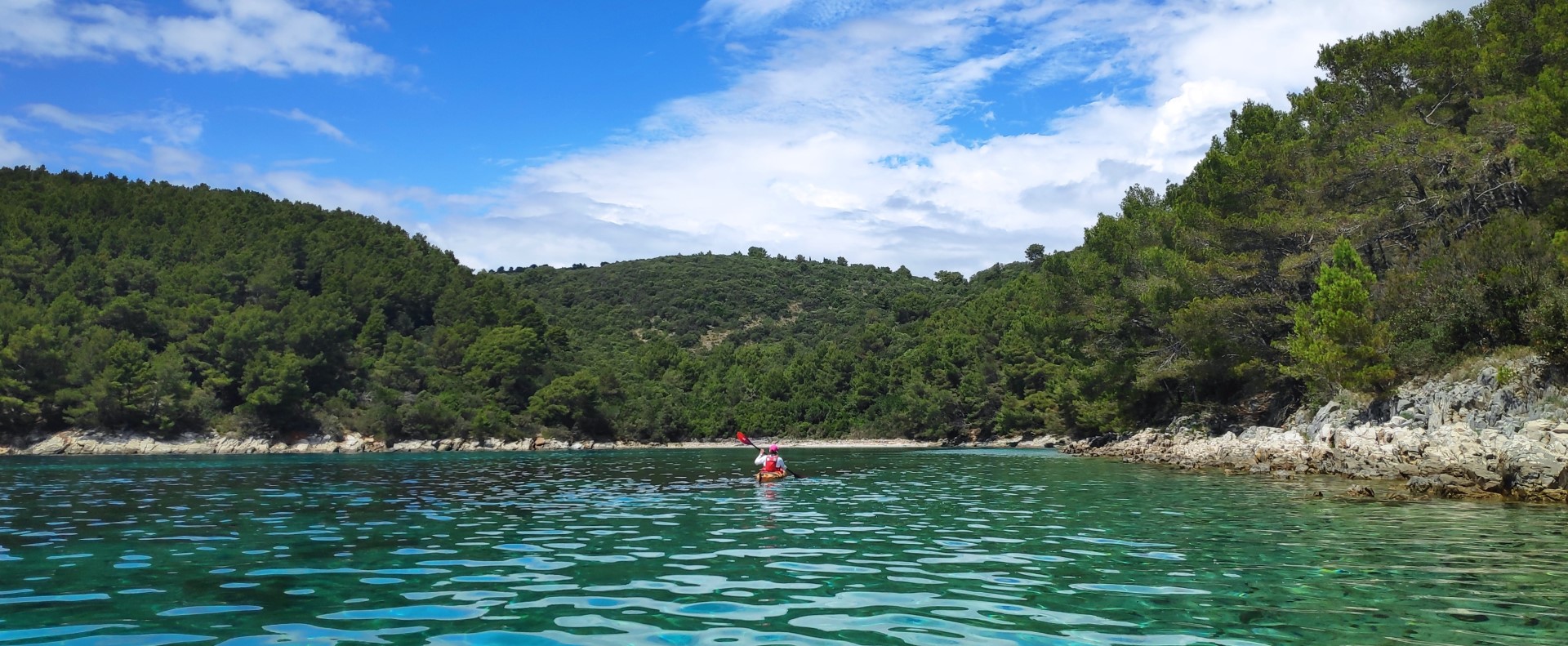
Rasovatica is on the same note as aforementioned ones, but it has two inlets to choose from.
Okavina is a small beach in otherwise rocky coast. It is 5km form Sućuraj, and it looks to be the first one without a land path to it.
Juta Grma Gornja translates to Angry Upper Grma, and we have found nothing angry about the little beach that hides behind that name. The word juta or ljut is often used to describe a geographical area that is very hard to access due to harsh environment and vegetation.
Juta Grma donja or the Angry Lower Grma is a small beach with a stone arch above it, giving it an appearance of a cave.
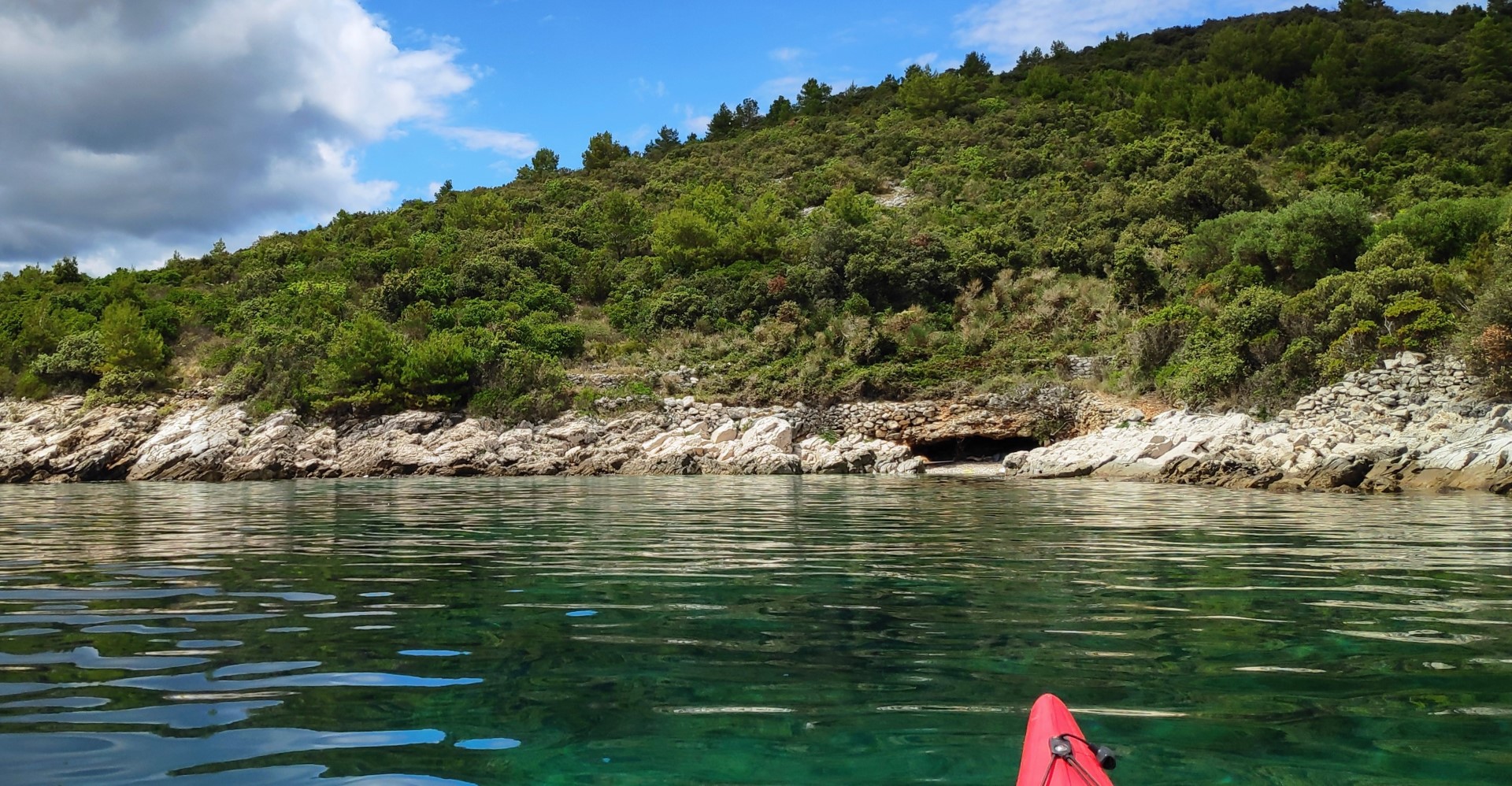
Slivanjske lučice is an open bay with two inlets. One on the east has a small beach.
Carevića is a deep bay with a beautiful beach at the end. Lots of Aleppo pine shade. Looks like it is accessible on foot.
Mrtinovik has two inlets, and both have a beach. One on the east seemed to host a tavern. The cute little tavern that would be a joy to visit if this was a normal summer. Now it was closed, but it got us daydreaming about tuna steak and a glass of red wine .
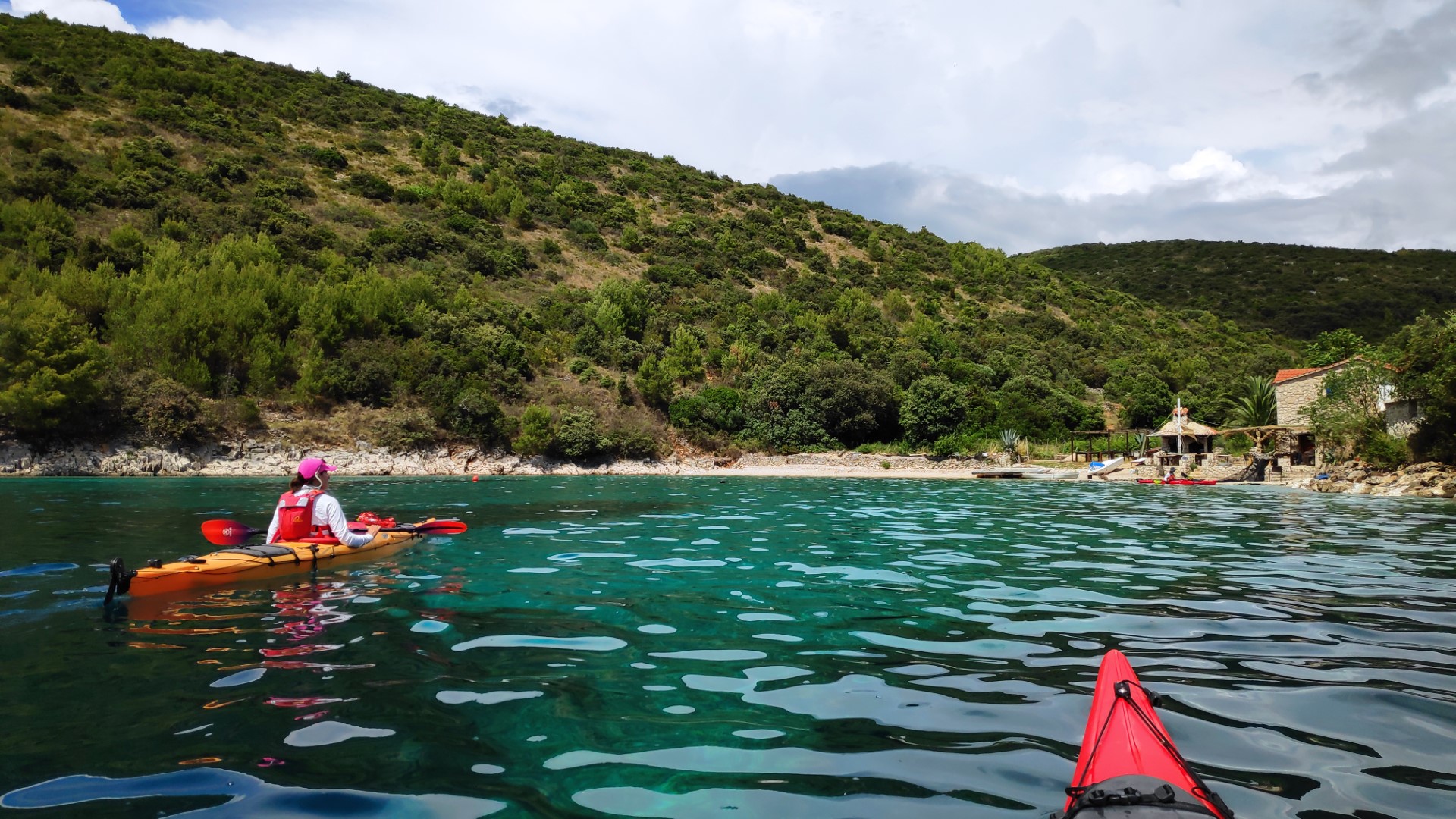
Borovik is a beach in otherwise rocky coast.
Ržišće is, by many of our standards, the most beautiful bay we came across. We liked it so much we have decided to call it a day right here, although it was just 2 PM, and spend a night here. One abandoned and one still in use cottage that serves as a shed for fishermans tools, one perfect pebble beach, grassy plot of land, thick shade from the Aleppo pines this one had it all!
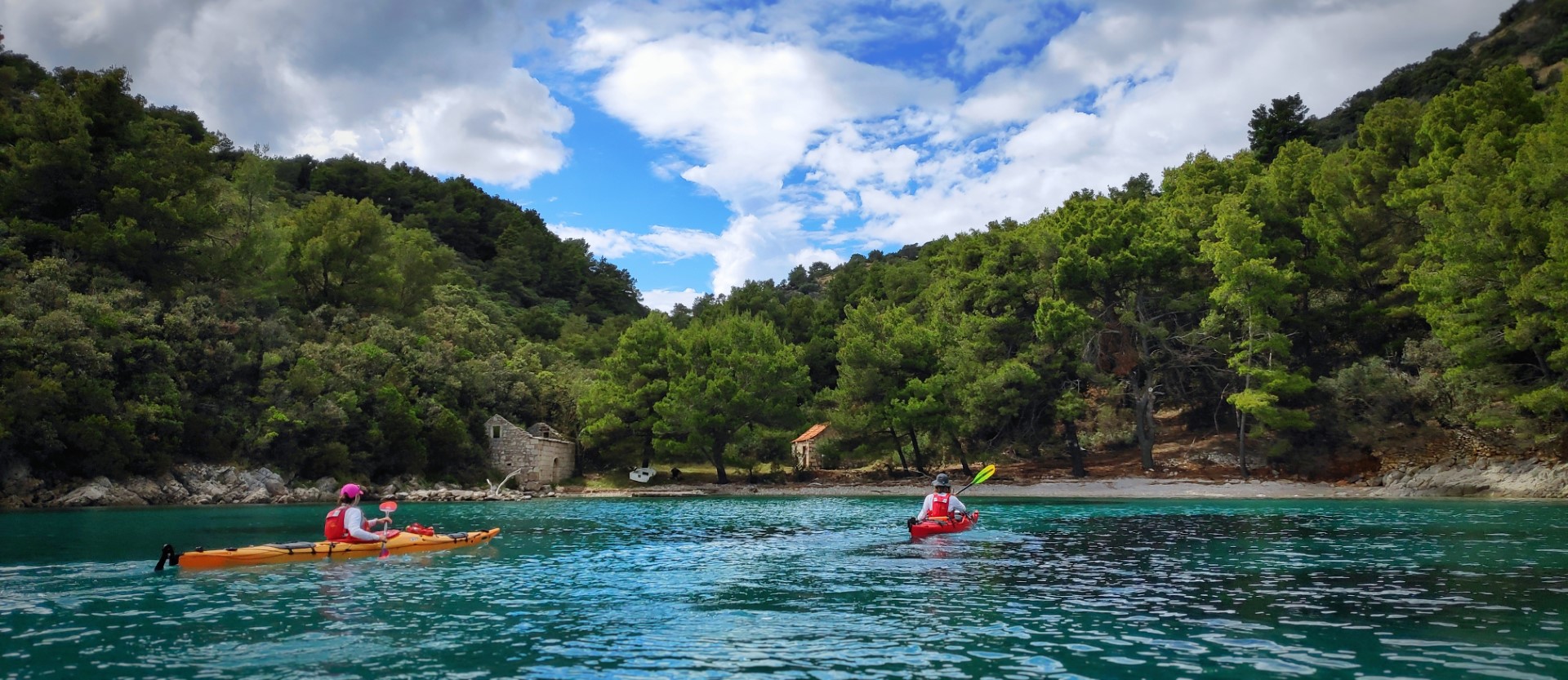
Veprinova has two inlets. The bigger one on the west has a cute little beach at the end.
Kozja translates to Goat’s bay. It is inhabited bay where the old and modern are intertwined. Looks cute, and looks like it is accessible using an unpaved road.

Duboka translates to Deep bay. We’ll have to take it’s word for it because we were not able to check it out all the way as this is where sea cages for fish farming are placed. The structures we could see from the distance were there to support this business activity.
Doboška pazuha is a tiny beach in a rocky notch.
Mala Burina pazuha and Vela Burina pazuha are also small beaches, but these look like they were used. Stonewalls around them, and a couple of small boats on the shore gave us the clue.
Smokvina is one big, beautiful pebble beach with lots of 20th Century architecture. Judging by the proximity of the residences to the sea, bay offers good protection from the strong south wind we call Jugo.
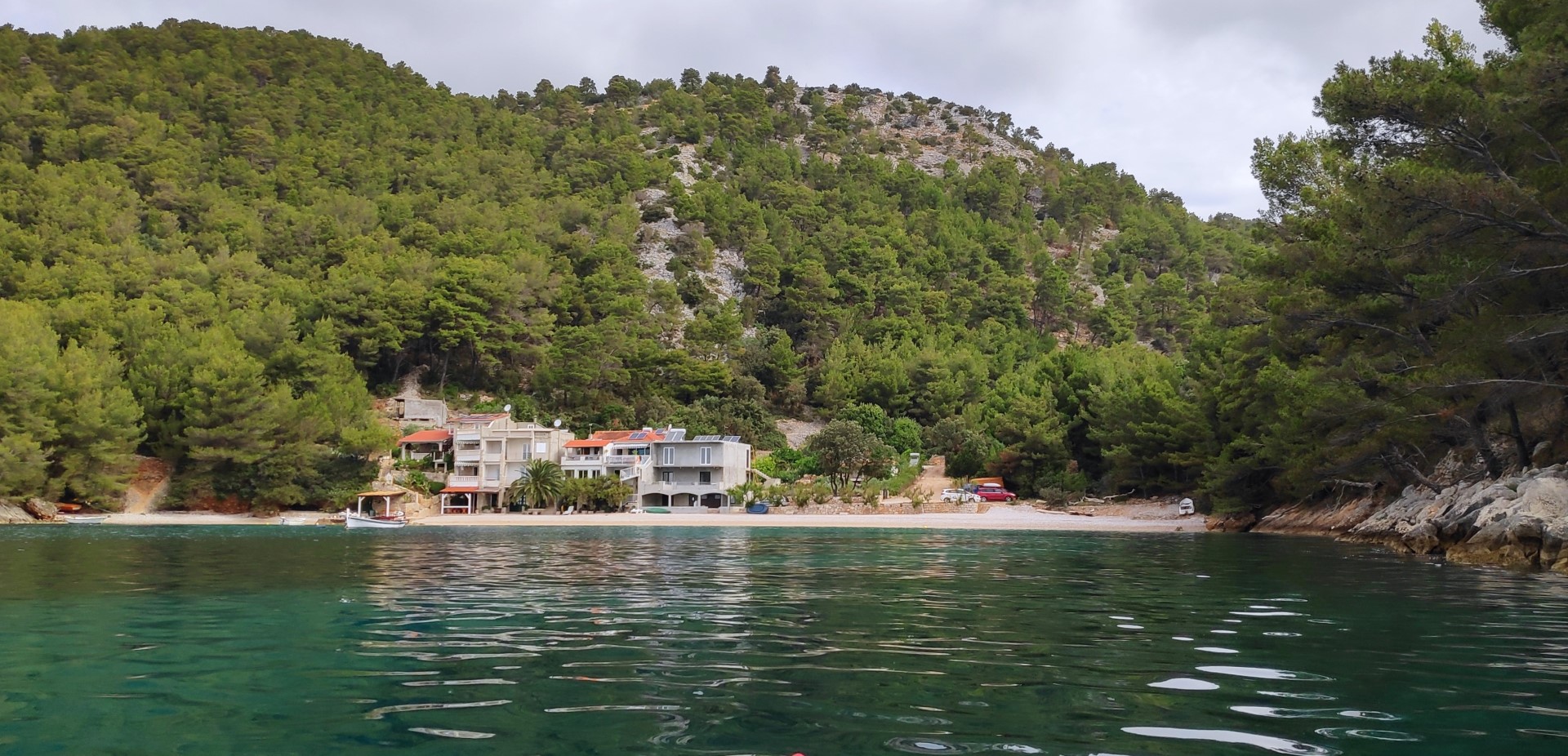
Jarčišće bay doesn’t offer much to a kayaker.
Lađena has a nice little beach, and one small village way above it. Looks like the village is accessible only by sea.
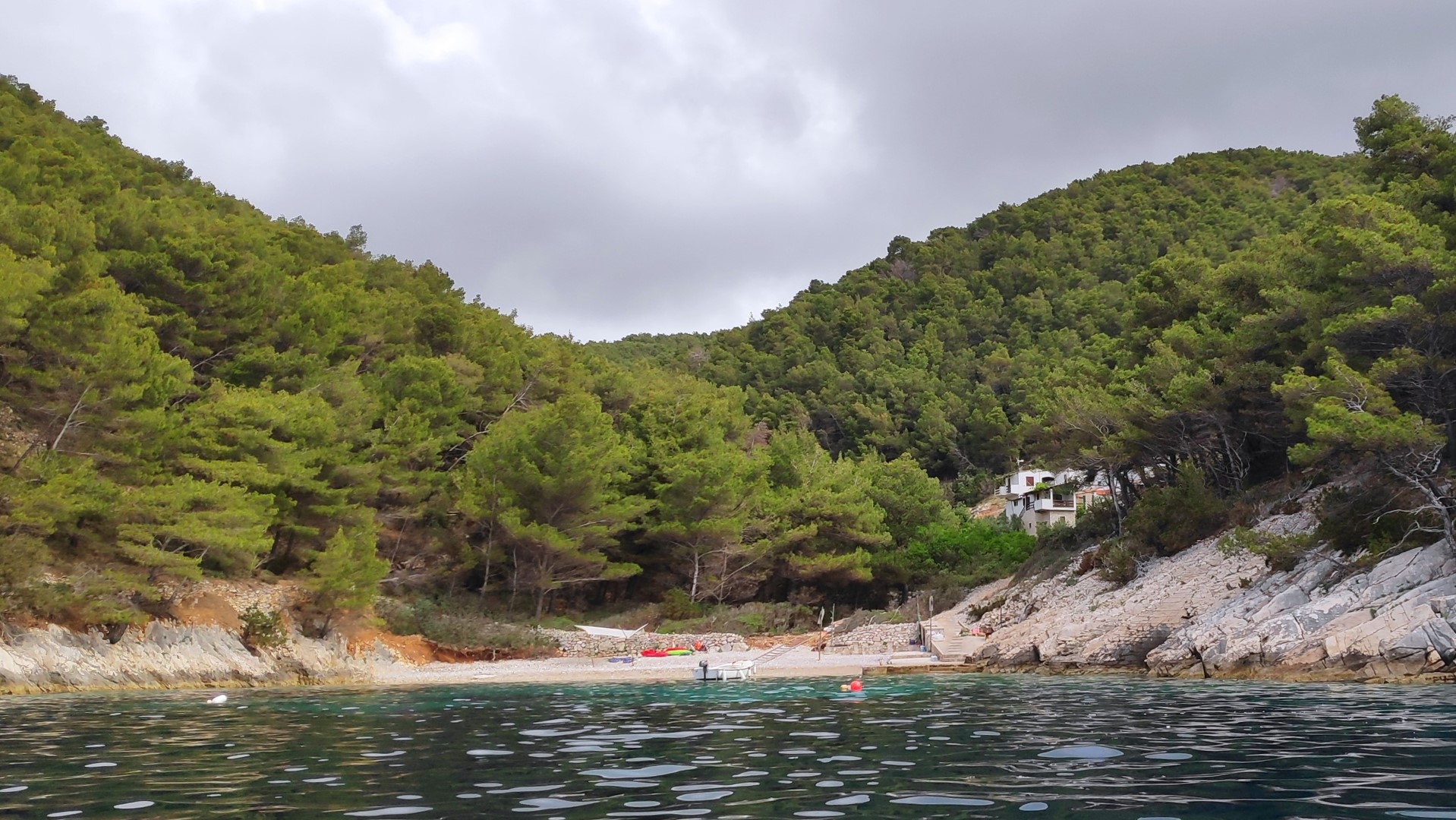
Gornji Pelinovik is one big pebble beach and two summer houses on one side of it. Peaceful little bay.
Donji Pelinovik is similar to Gornji Pelinovik, but more developed. Both are accessible by an unpaved road.
Gornja Raca and Donja Raca are two tiny beaches in otherwise small, unprotected rocky bays.
Smrska is an absolutely gorgeous small coastal village, and we were surprised we have never heard of it! Bunch of old houses spread around, one small port for the boats of the locals, a church and large palm trees. Just gorgeous!
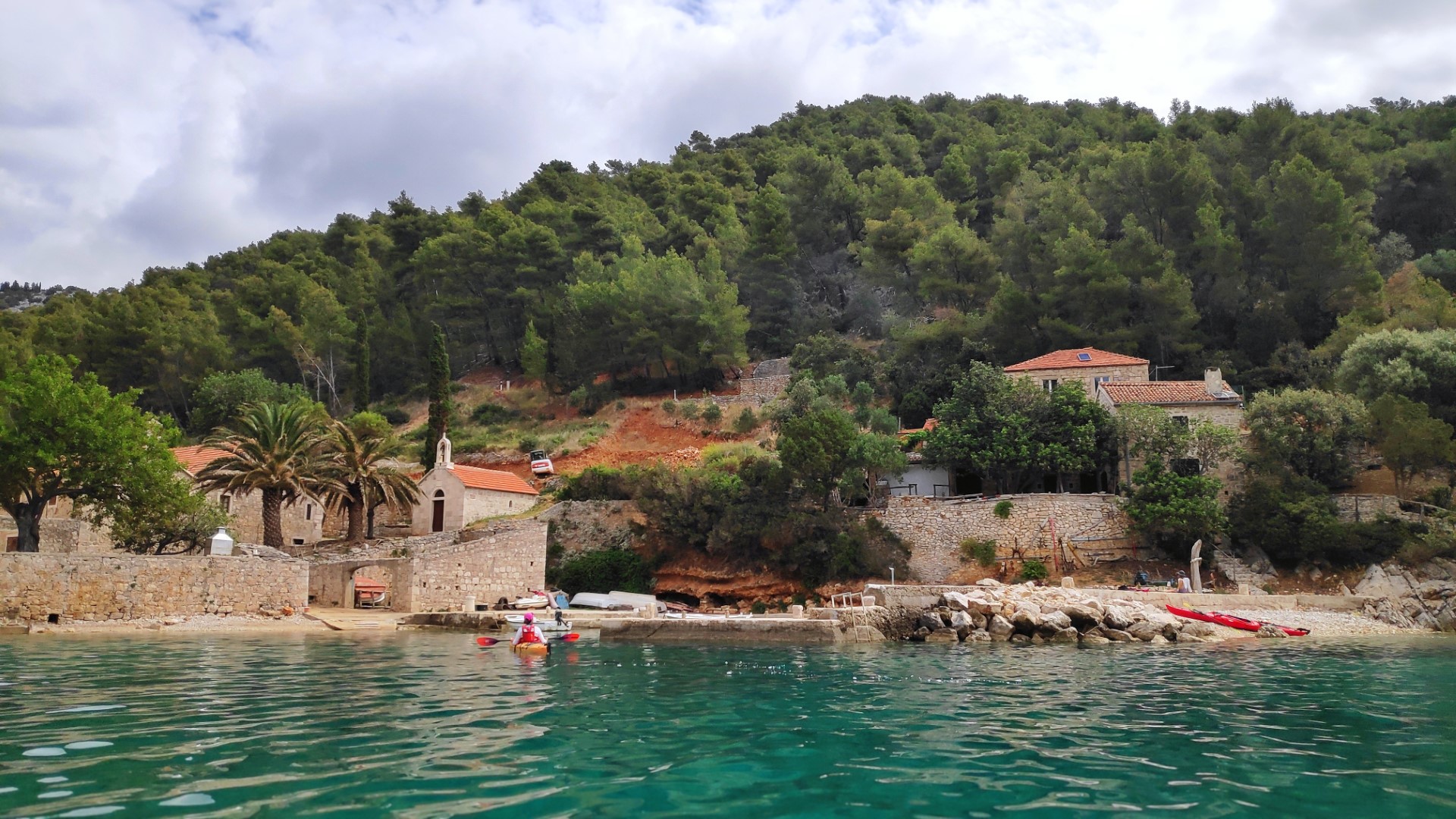
Kozja has a heavenly beach and just a couple of summer houses and one small pier on its east side. There is a large agricultural area in the background and an unpaved road connecting it to coastal village of Bogomolje. Note this is the second Kozja bay we’ve seen today.
Veprinova is very similar to Kozja, but its heavenly beach looks like it is shared with more people. There are at least ten summer houses, a small pier, and it looks like one or two taverns that would be open on a normal summer day. Note this is the second Veprinova bay we’ve seen today.
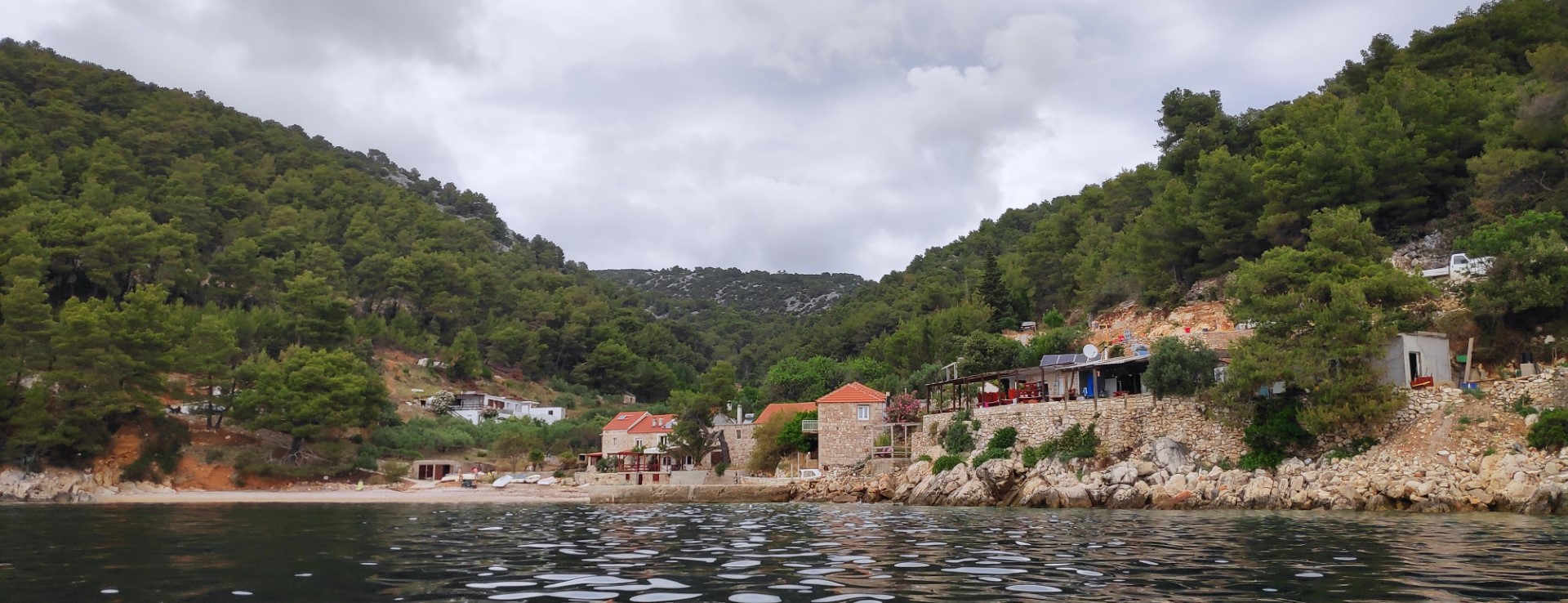
Bočac is a beautiful beach, just around the corner. Let’s call it a suburb of Veprinova 🙂
Rapak is interesting. It is a big bay, with a beach on the left and right side. In the middle, summer houses reach almost all the way to the sea.
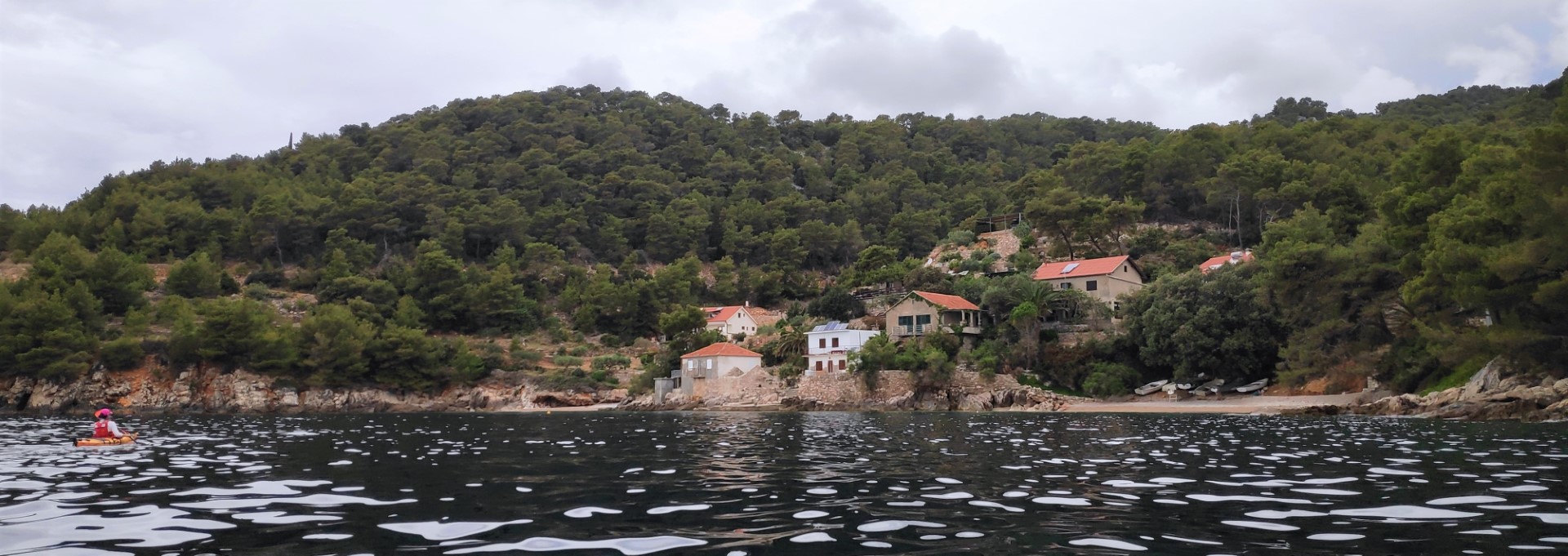
Tvrdni Dolac is similarly interesting and shaped as Rapak, but more developed. Two beaches, summer houses in the middle and around them. Looks like it could host a vivid community of people.
Torac is just around the corner of Tvrdni Dolac, with residences connecting these two bays. Torac has one pretty large beach for the size of the bay.
Soca is next in line. One lovely, medium-sized beach, and just a couple of summer houses way up from the beach.
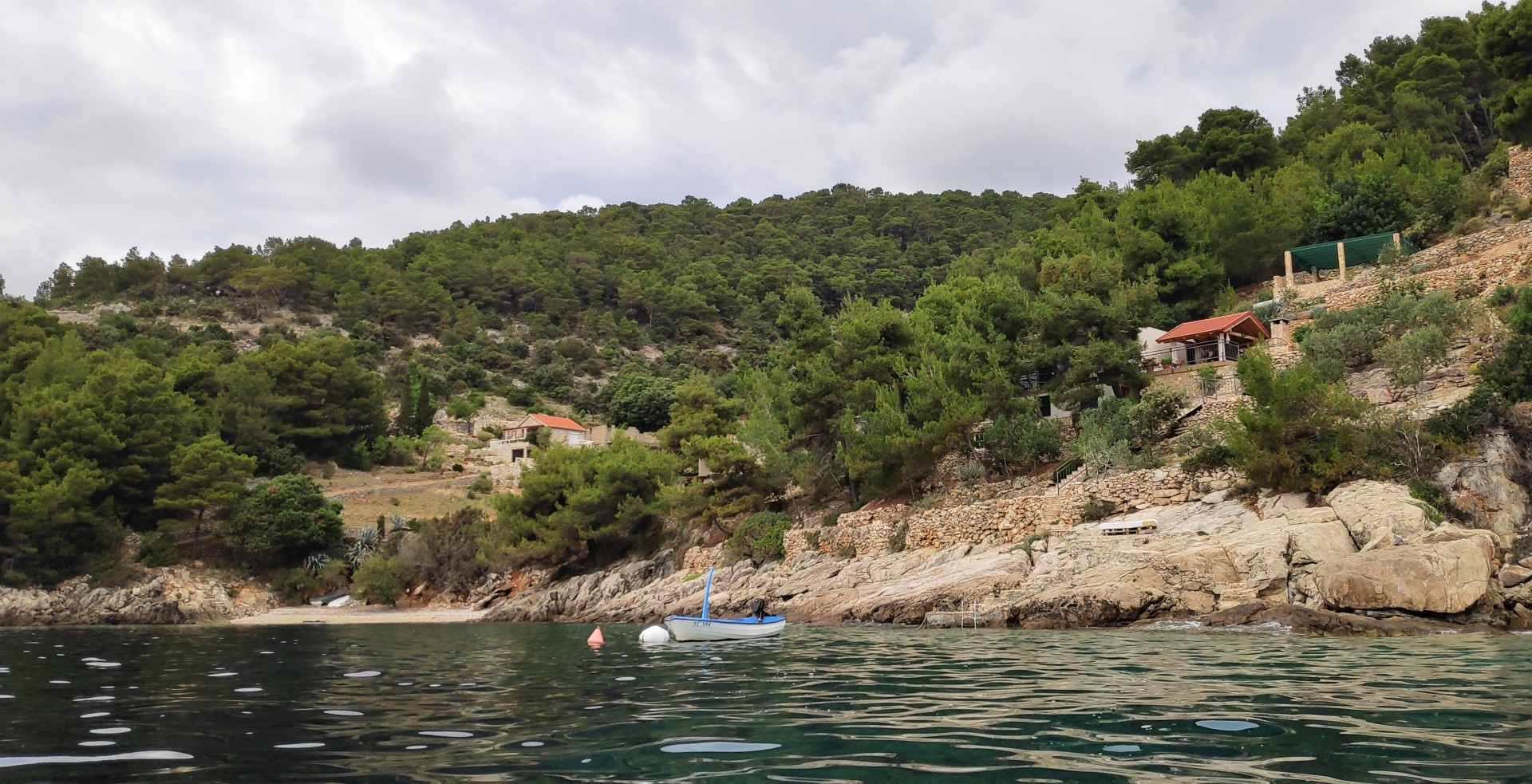
Lučica translates to Small Port. It is a wide, open-style bay with summer houses spread around. Mostly rocky, with two small pebble beaches on the sides.
Skozanje offers a big beach stretching from one end of the bay to the other. 20th Century architecture residences are harmoniously spread around, and there is a lot of agriculture activity on the land stretching up the hill. Unlike almost all of the bays so far, Skozanje is oriented more toward the west.
Krivi dolac is uninhabited, but there are signs of human efforts here in a form of a stonewall supporting or protecting plots of land from the sea. There is a small beach and one small cave.
Jedra can be translated as Sails or Buxom. We are not sure which one could it be, as toponyms in Croatia can be misleading, and not so obvious. But we can tell you for sure it is a beautiful little bay with cute four to five summer houses neatly packed around one pebble beach.
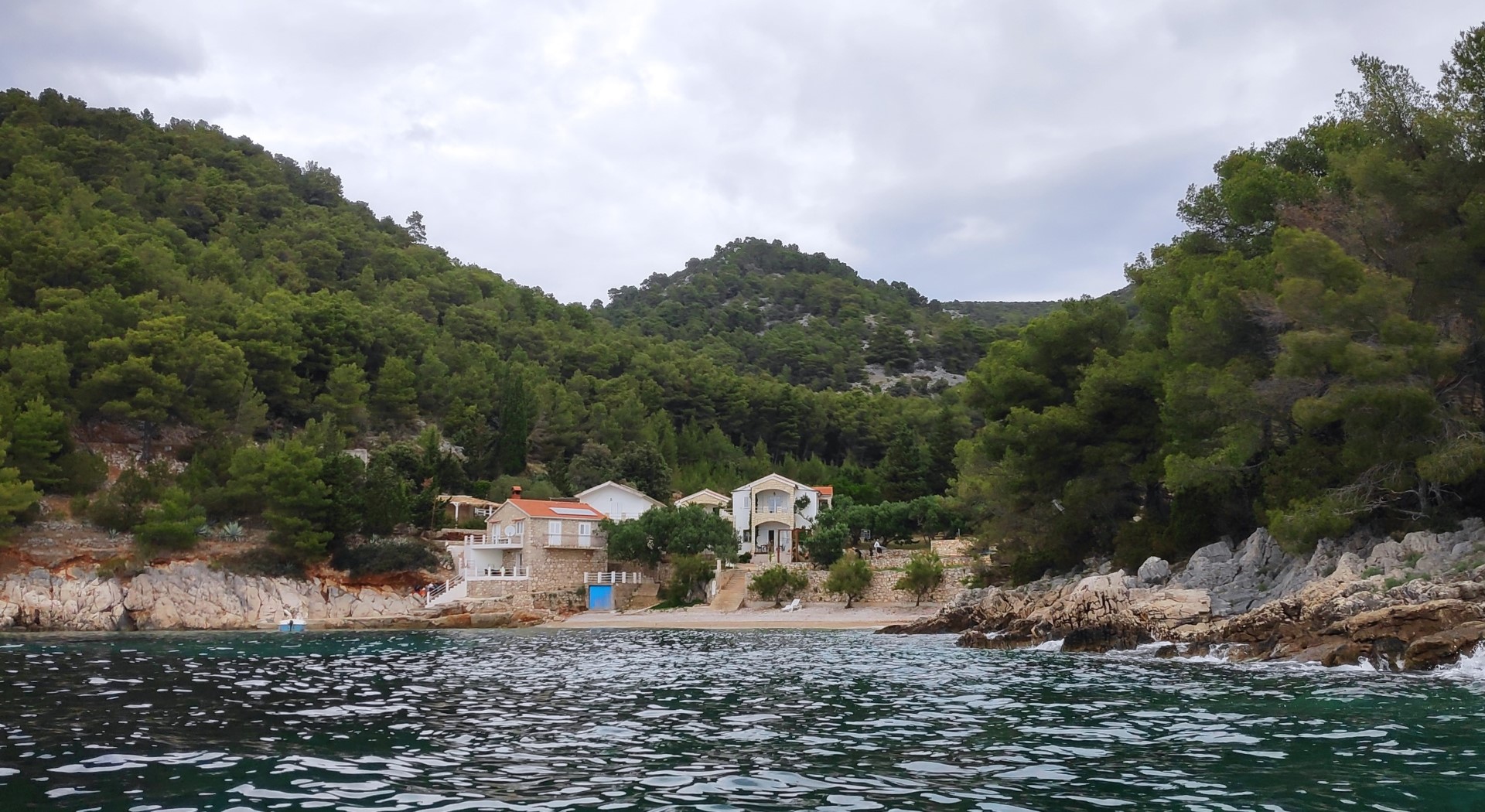
Srhov dolac has more residences spread out around two small beaches. Looks harmonious, and the vineyard stretching high above the bay gives it an authentic look that we were hoping to see on this south side of the island.
Tetikova is nothing to write home about. Just a wide notch in the silhouette of the island.
Tiha is one small beach, with no houses around. Dry stone walls in the background, and lots of green.
Medvidina is something worth checking out. It consists of three bays with three beaches. Most of the summer houses are on the far west, and there is a Robinsons style camping spot hidden somewhere in the shade of the olive trees. We enjoyed the hospitality of this bay overnight, as Brunas relatives, Jure and Ana, own a summer house there.
We were welcomed with local wine and grappa, and our host provided meat and vegetables for the grill. After an enjoyable chat about our adventure, we were left on our own to enjoy the beauty and peace of Medvidina. We also enjoyed comfy beds and warm showers. And the coffee in the morning … Oh, what a place to watch a sunrise!
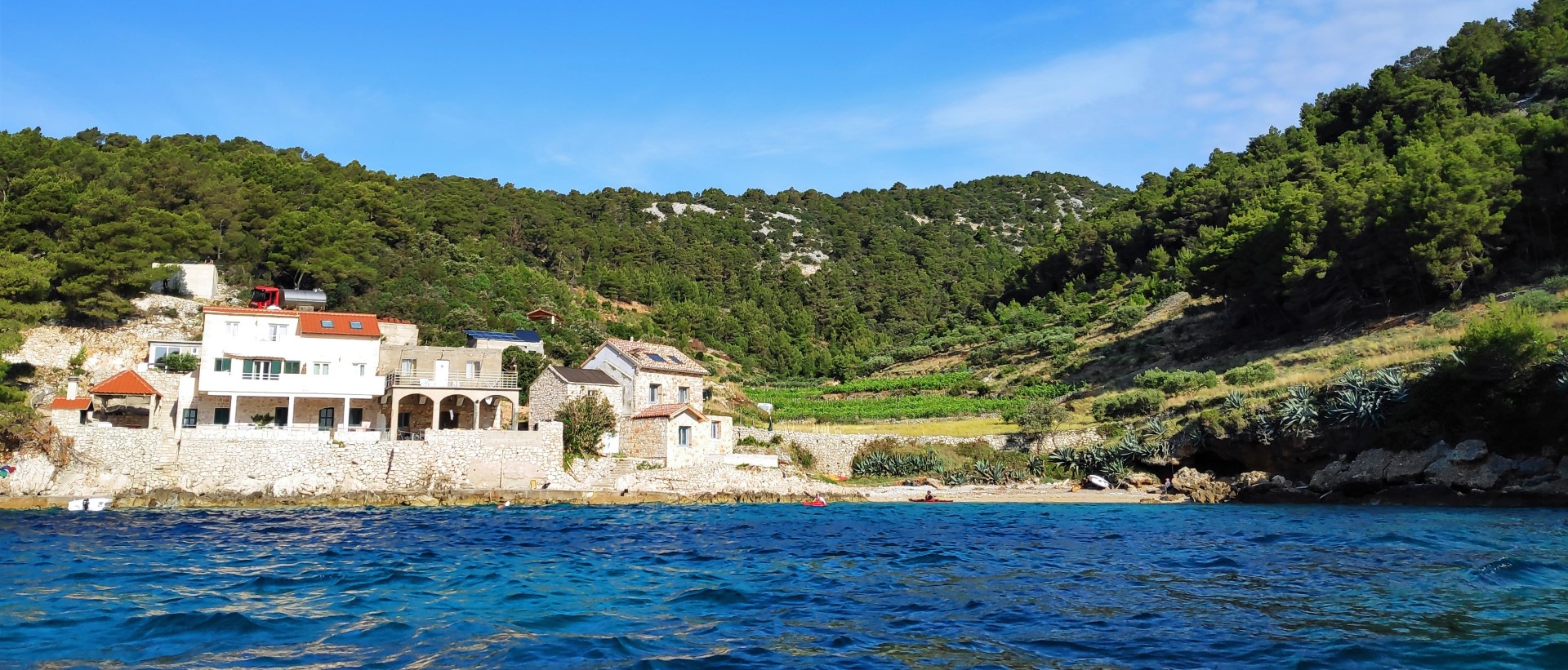
The name of the bay has to have something with the presence of a Mediterranean monk seal, one of the most endangered mammal species on Earth. Local communities, like one on Hvar island, named this 300kg seal sea human or sea bear, and the latter is likely the origin of the name of this bay (bear = medvid), as it probably habituated underwater caves here.
The last specimen of this specie in the Adriatic Sea was found in 1964. In recent history more and more evidence of presence of this animal is revealed.
Križna lučica is a large bay with a small beach at its end, and nothing else. Still lovely.
Strvanj is a big bay, with two inlets and two beaches. One summer residence between them.
Golubinka is similar to Strvanj but with more stonewalls shaping the farmed land around the only summer house in this bay.
Mali Črvanj is one of those bays and beaches that look like they have been claimed by the two-sizes-too-big residence built in the middle of it. Lots of stonewalls around.
Veli Črvanj looks authentic as can be. One nice pebble beach, and just a few houses and cottages, most of them looking abandoned.
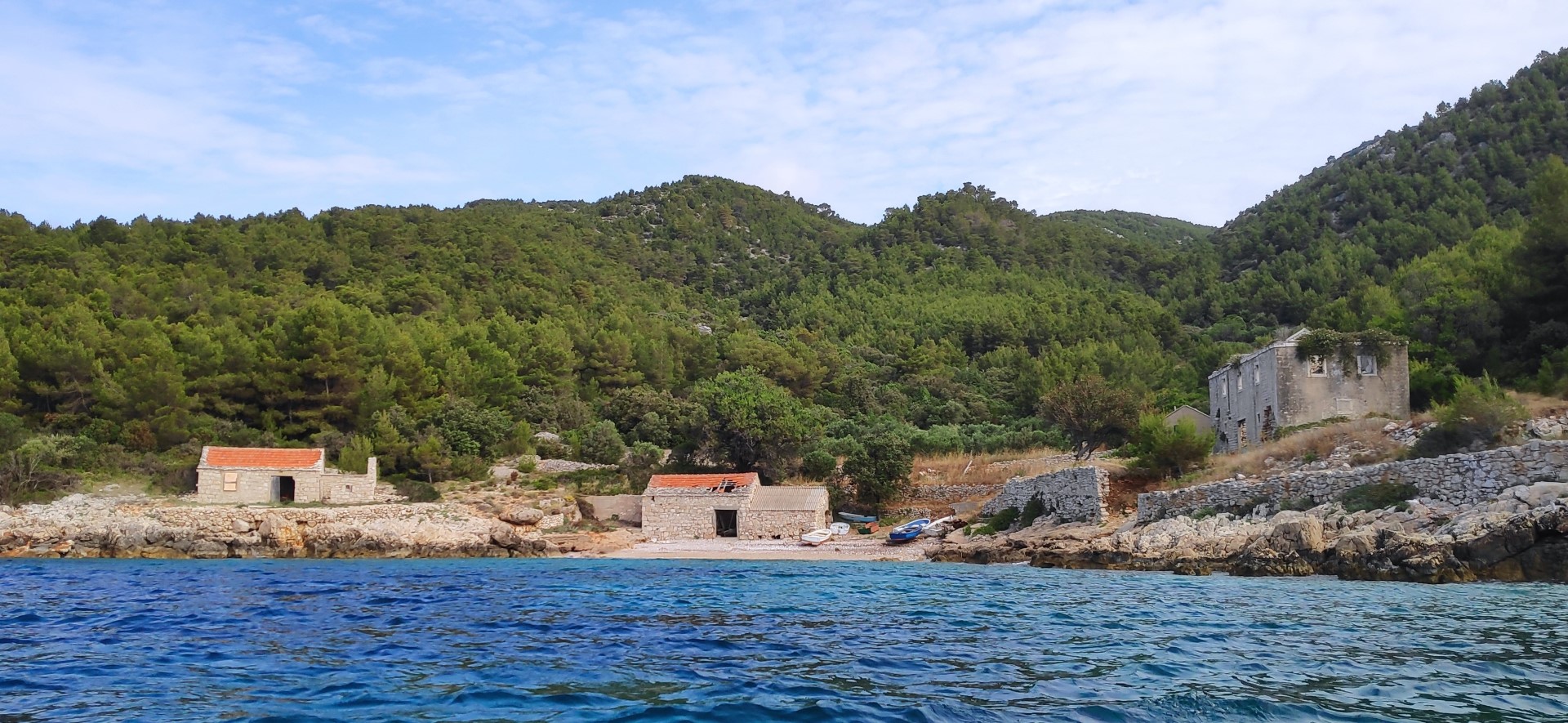
Badnjena is big and uninhabited. Cliffy coast divides the beach in two, making for what we believe is the smallest pebble beach on this island. Just gorgeous!

Vratinja paklina has a nice, well protected pebble beach, and it can be a kayakers perfect home for the night.
Repovac on the other hand, is not much of a use to a kayaker.
Kobil dolac is an all-rocky environment, with one cottage above the bay. Look secluded and equally inaccessible by land.
Duga pazuha is just beautifl! Small beach, one fishermans tools shed placed in the middle, and one small cottage in the shade above the beach. Carefully planted olive trees in stonewalled terraces around. Just beautiful.
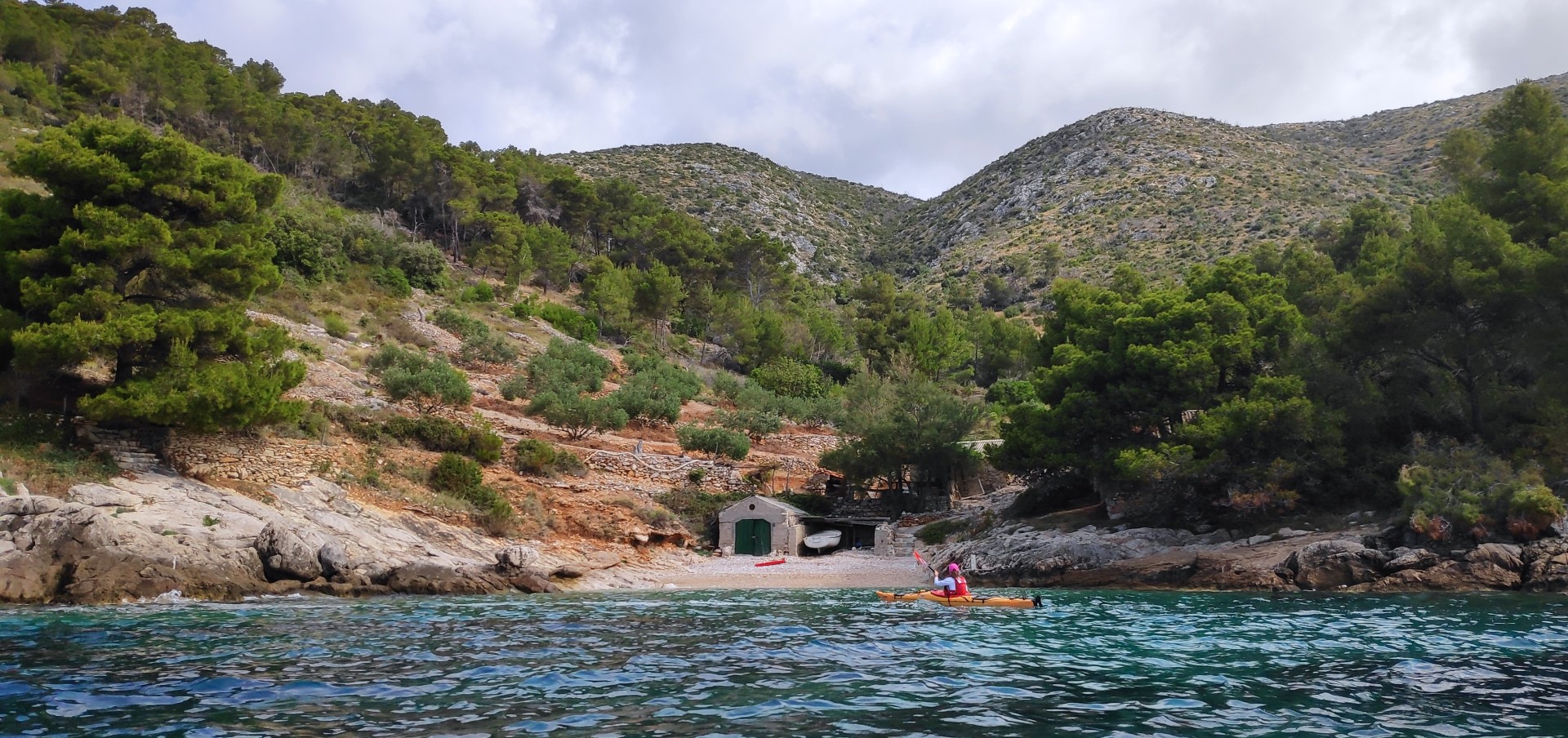
Prisinjak is also beautiful, but more modern. Two or three summer houses share its beach, and the bay is accessible by an unpaved road climbing up to Zastražišće and Poljica.
Tavna špilja is a rocky notch with one old stone cottage. ”Špilja” means cave, and there is one that bears the same name high above the bay.
Ljubinka is someones piece of paradise, as there is only one old stone house next to the sea and a small beach. Bay is completely surrounded by Aleppo pine forest.
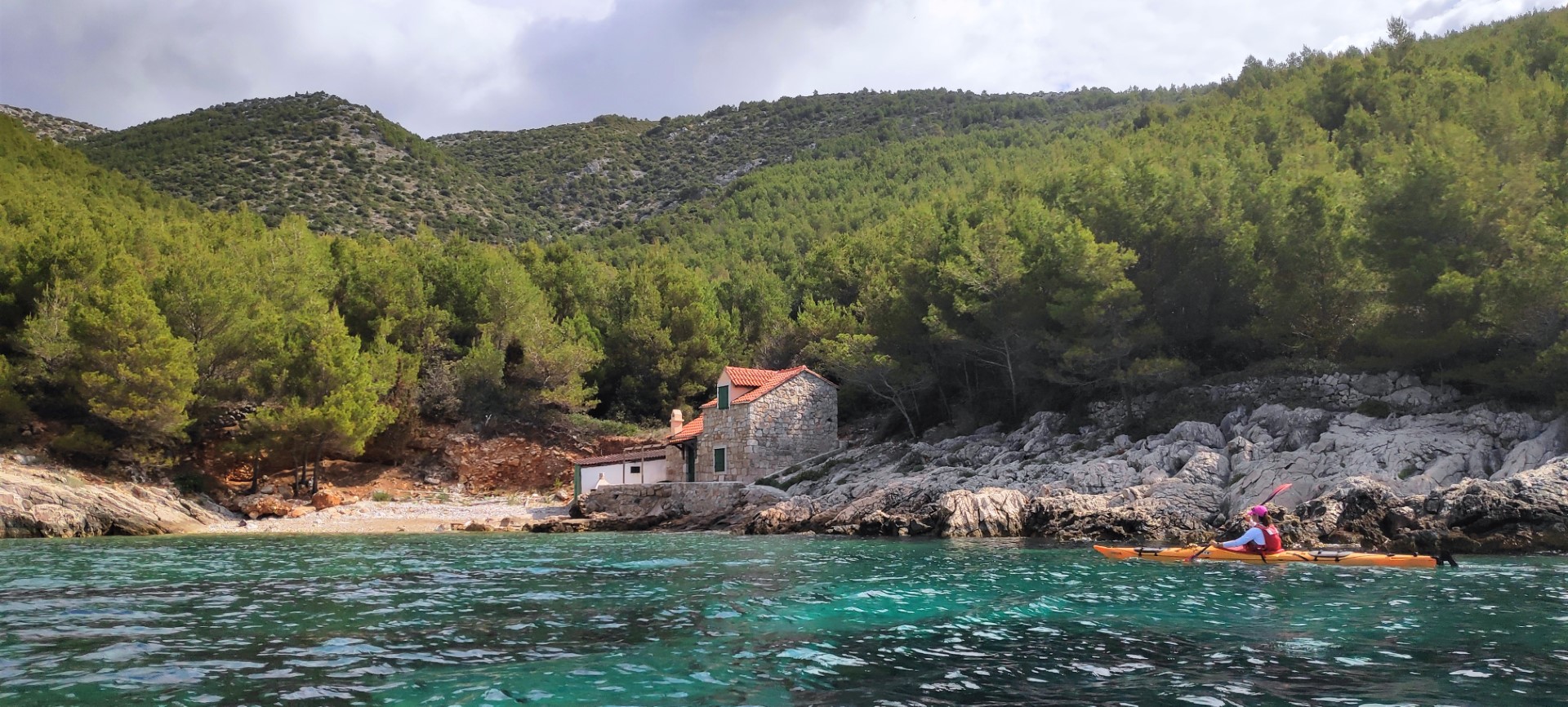
Veli bok is just a very small, very rocky beach.
Tegi is a bay on a map. In reality, it doesnt exist.
Ravni doci is a cute little stone cottage in a rocky environment. No beach.
Dragojevac is similar to Tegi. Nothing there.
Stiniški dolac looks like it could be related to Dragojevac.
Vela Perna has a name that confuses, as one would expect a big bay with something going on in it. Actually, it is not big, and it houses nothing.
Gromin dolac is a coastal village developed away from the coast, and along the coast just a few summer houses can be seen. In 1950s some 170 people lived here, and today only a couple. But this amphitheater shaped village comes back to life every summer. As we approached, a monumental 16th Century summer house, Budić-kuća, welcomed us.
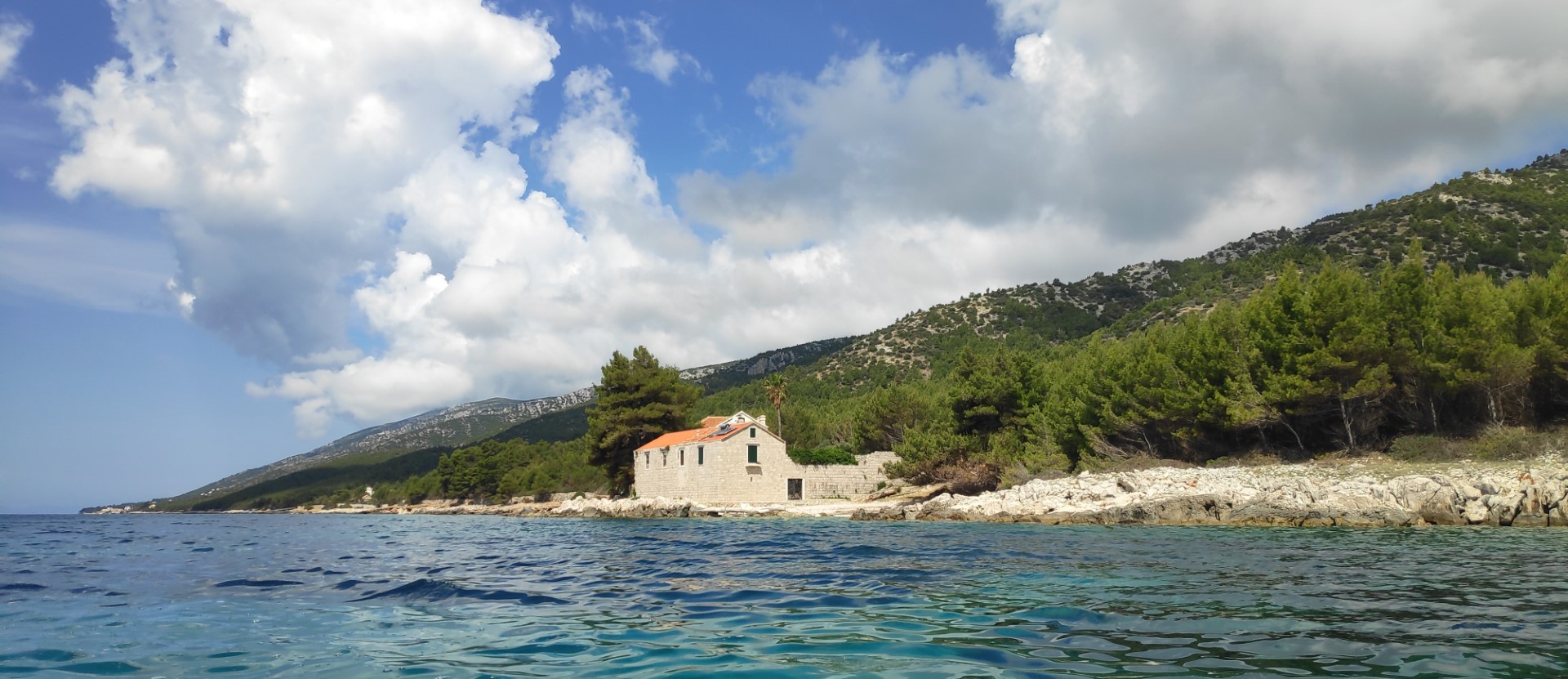
Bay of Gromin dolac has one big beach with a cave-like arch that looms above it, and it is reasonably easy to access by car as there is a paved road to Zavala, and a stretch of unpaved one to Gromin dolac. Well above the bay is Grapčeva špilja, a cave where the most important evidence of prehistoric culture in Adriatic were found.
Fragments of pottery dating back to 4000 BC with a drawing of a sailing boat represent the oldest drawing of a vessel in Europe.
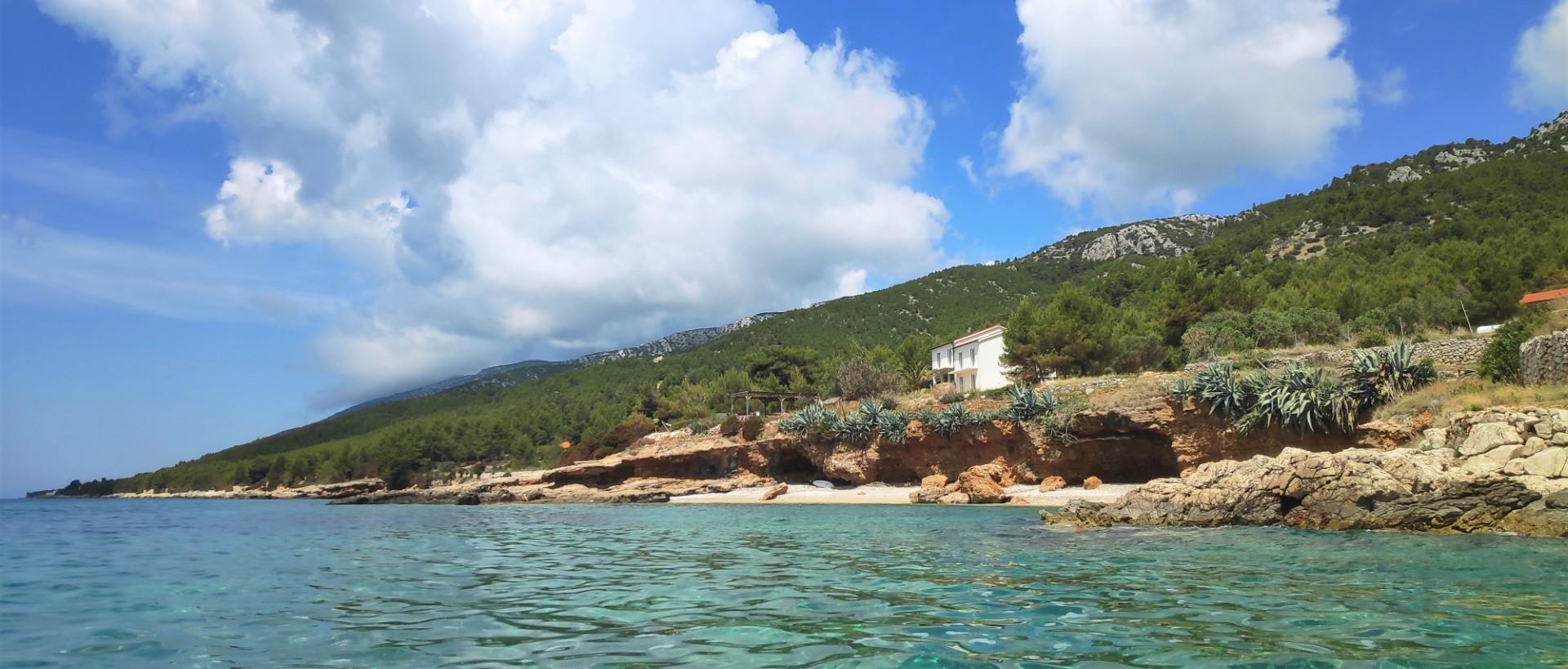
To a kayaker, coast going further becomes very diverse, with lots of signs of human efforts involving tourism. Also, this is the part of the island famous for its Plavac Mali red wine and the steep, rocky vineyards designed to grasp as much sunshine as possible.
Gnjila bay has a nice, big beach, unlike Gnjila bay we have seen on the north side. Being little bit away from the villages, it looks like it could be an unofficial nudist beach. Interesting geology with arches and caves continues.
Žutica looks nice and friendly. Lots of shade and activity.
Rarog is a medium-sized pebble beach outside of Zavala village. Like Gnjila, it could be a nudist beach.
Zavala is one of the well-known villages of the south side. Partially because the only road connecting north and south side of the island is the one from Pitve to Zavala, with 1.4km long and very narrow one-lane tunnel. Today, Zavala is a home for some 140 people. There are restaurants and bars, markets, lots of apartments to stay in, small port, and couple of pebble beaches to choose from.
History of Zavala is interesting, as it developed by residents of Pitve as a remote village on the south side. Name of Zavala (or Zaca) can be traced back to 15th Century, while the church of Sv Petra Veronskoga (St Peter of Verona) dates back to 1331.
Petarčica is a bay on the outskirts of Zavala village. Summer houses and a camp are developed around two pebble beaches.
Zagon is more beautiful than this picture shows. It is far away from the villages, yet accessible on foot. Beach of Zagon is named Eva, and it is a gem. No shade though.

Paklina is a bay of Ivan Dolac village. Village that dates back to 15th Century today is known for its steep vineyards. We have counted five pebble beaches, couple of restaurants and bars, a bakery and a market and numerous Air BnBs .
Donja plasa is just a bunch of rocks in the sea.
Šuplja stina meaning “hollow rock” is a very interesting bay. It is a well-known rock climbing paradise named Cliffbase. Beside numerous epic climbing routes, there is a beautiful little protected port, small pier and one small beach. Make sure to check it out if kayaking nearby.
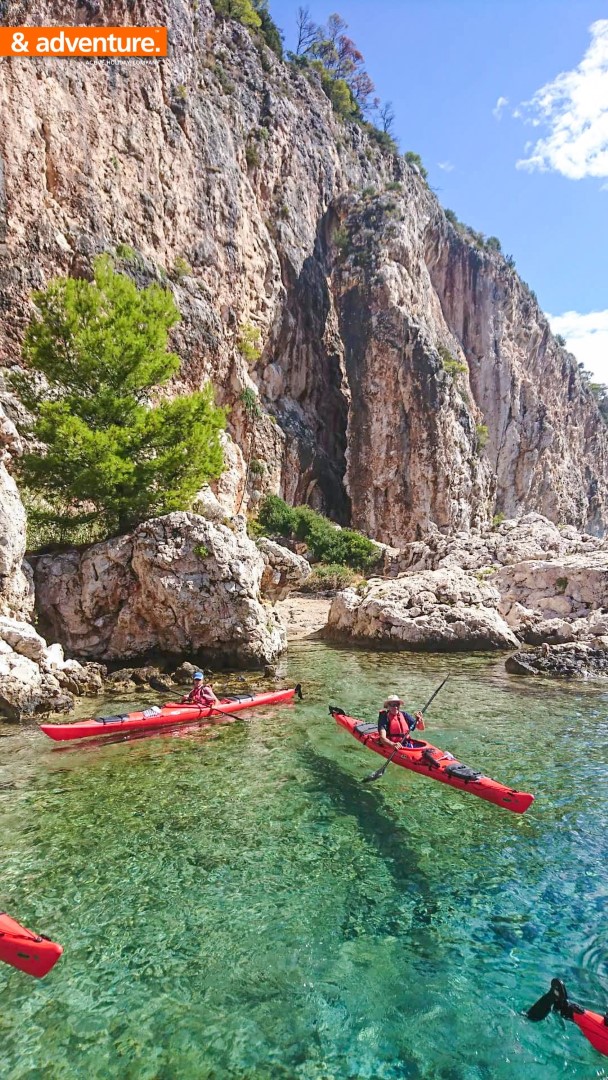
Luciska is a picture-perfect bay with a pebble beach called Skala divided by a big rock in the middle. Positioned on the outskirts of Sveta Nedjelja, this beach attracted many. Today, and there is no other way to say it, it is becoming devastated by illegal building of all sorts of walls and terraces that divide the beach.
We hope that what we saw will be taken down, and the beach will be restored to its former beauty in no time.

Sveta Nedjelja (Sancta Domenica) is a vivid little village beneath Sveti Nikola (St Nicholas), 628m high peak of the island. It is a permanent home to some 130 people, and it is known for its vineyards and some of the best red wines. Bay itself is quite rocky, but there is a small, well protected port with a small beach on one end perfect exit point for a kayak.
There are restaurant and lots of AirBnBs along the coast. Center of the village is positioned higher up the hill with a church, a market, wine producing facilities, etc. Even higher above, there is a huge cave of Sveta Nedjelja that was habituated since Neolithic era.
Today, inside the cave there is a small church and the ruins of the monastery of the Sancti Augustini hermits, used until 1787. It is quite a hike to get to the cave from the sea level!
Velo Lučišće bay is one of the most beautiful bays of the south side. A decent size pebble beach, with partial shade and an entire mountain looming over it. It is accessible on foot, and can be a popular place! We were thinking about this bay as a camping spot, but decided to continue where we could be on our own.

Crvene stine meaning “Red rocks” is not a bay, but it certainly is something a kayaker wants to explore. Check it out.
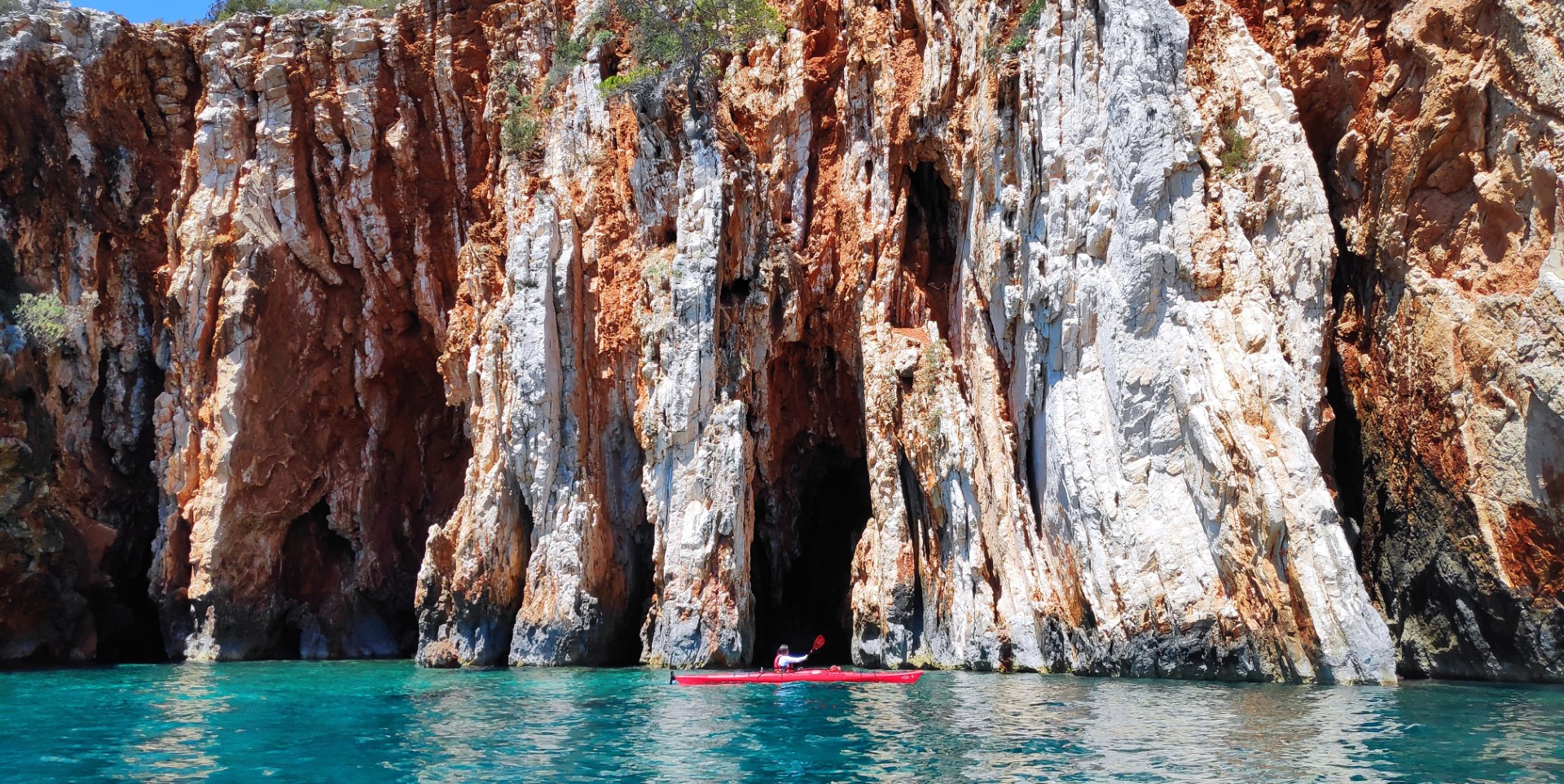
Pišćena is a peace of heaven. One beautiful pebble beach below an abandoned summer house, with lots of green and shade. It is accessible on foot, but it is a long hike from the unpaved road above, or Dubovica village on the west. That is why you wont find many people here. This is where we have decided to spend a night.
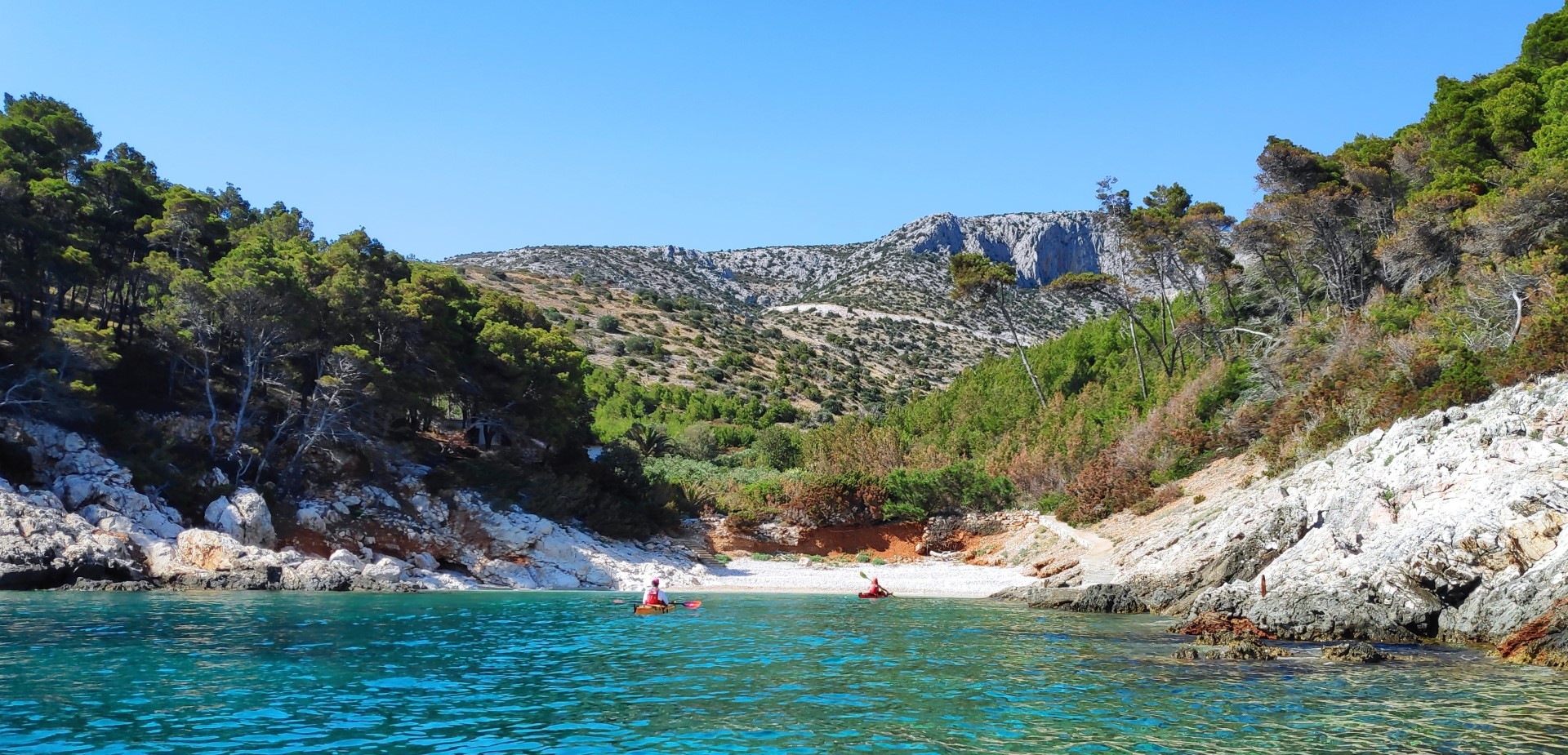
The following morning, we woke up and packed just before the rain. Some photos we will show here are from our archive.
Dubovica is one of the very popular bays. Picturesque stone buildings (noble family Kasandrić summer house stands out) stretching from along the wide pebble beach, couple of bars and restaurants . Just beautiful.
It is a place where even the locals like to spend an entire day at the beach, and the proximity of Hvar town also adds to its popularity. If you are about to explore it on foot, prepare for a hike starting form them main road to Hvar.
Velo Zaraće (translates to “big bay behind the cape”) is another very popular bay. Pebble beach oriented toward east and well protected by the natural rocky formations, with bars and restaurants attract many in the summer. It is, unlike Dubovica, accessible by car.
Malo Zaraće (“small bay behind the cape”) is not as nearly as popular as Velo Zaraće. Facing west, there is a big bay with lots of interesting rock formations, cliffs and couple of beaches. One old summer house right there on the beach is something to daydream about.
At the other end of this bay, there is a pebble beach of Pašćuka and summer houses above it.

Milna is a peaceful coastal village just 4km away from busy and vibrant Hvar town. Today, it is a popular summer destination for the guests that seek easy going atmosphere while on their vacation. There is a small hotel, a camp, bunch of taverns, restaurants and AirBnBs.
Milna bay has one big pebble beach, but it is a short hike away from the three bays described below. When in Milna, be sure to hike up to Malo Grablje, an almost abandoned, most charming little village hidden away from the coast.
Mala Milna is right next door. The bay has a perfect pebble beach, and a couple of taverns.
Velo Borče is a big bay with lots of interesting rock formations stretching into the sea. It can be hiked to, but it is much more enjoyable to explore from a vessel.
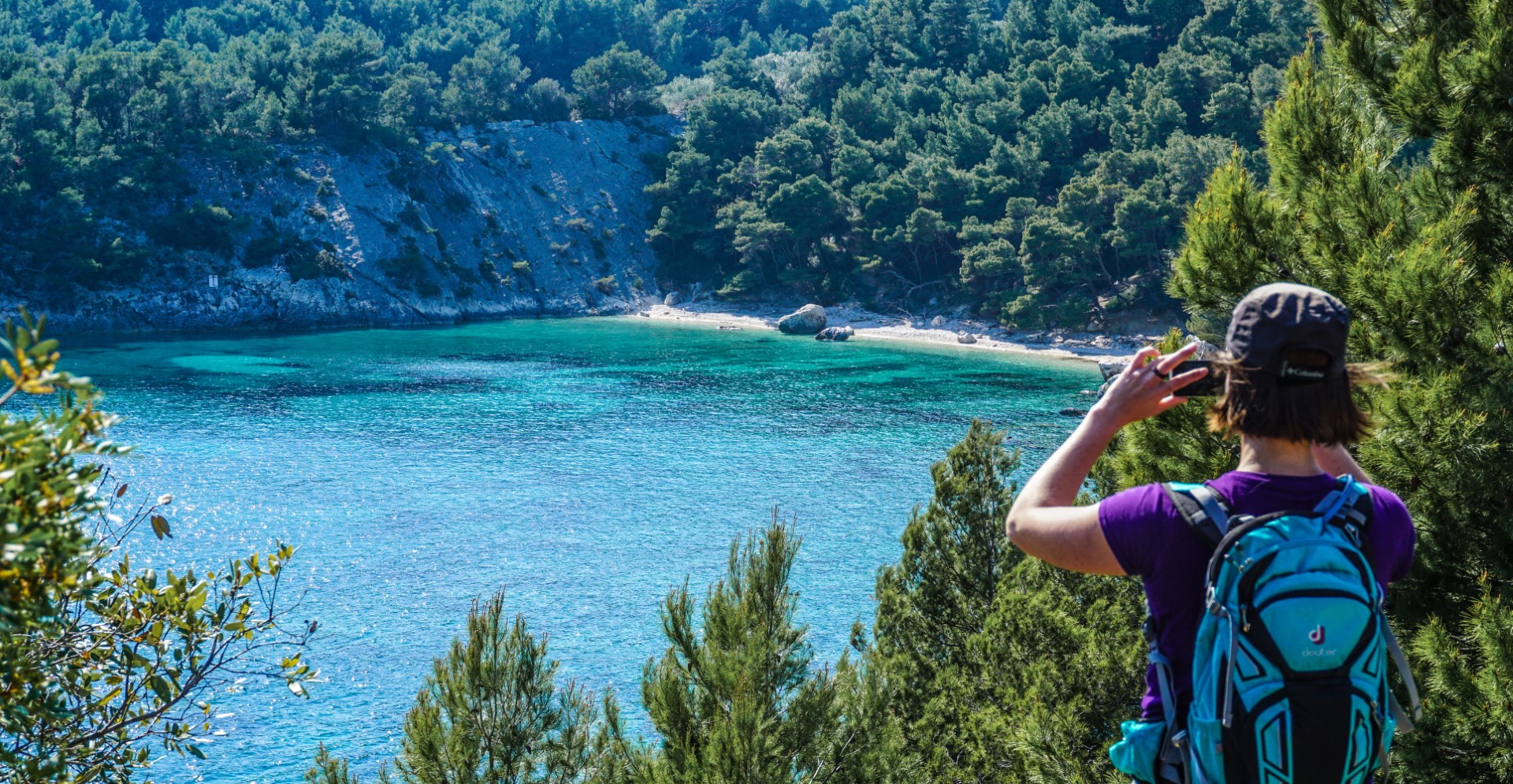
Malo Borče is separated from its bigger sibling by a rocky formation, and can be accessed on foot. It is one picture perfect solitary pebble beach.
Katolić bay is further down the rocky trail toward Hvar town. It is a rocky little inlet that offers nothing to a kayaker, but the colour of the sea is something to write home about.
Mekićevica is a bay with two inlets. One on the east hosts a beach bar/tavern called Robinsons, and it has a small pebble beach. One on the west is bigger, with unusually big, white stone pebbles big as an ostrich egg! Hikers love it, kayakers love it, everyone loves this bay!
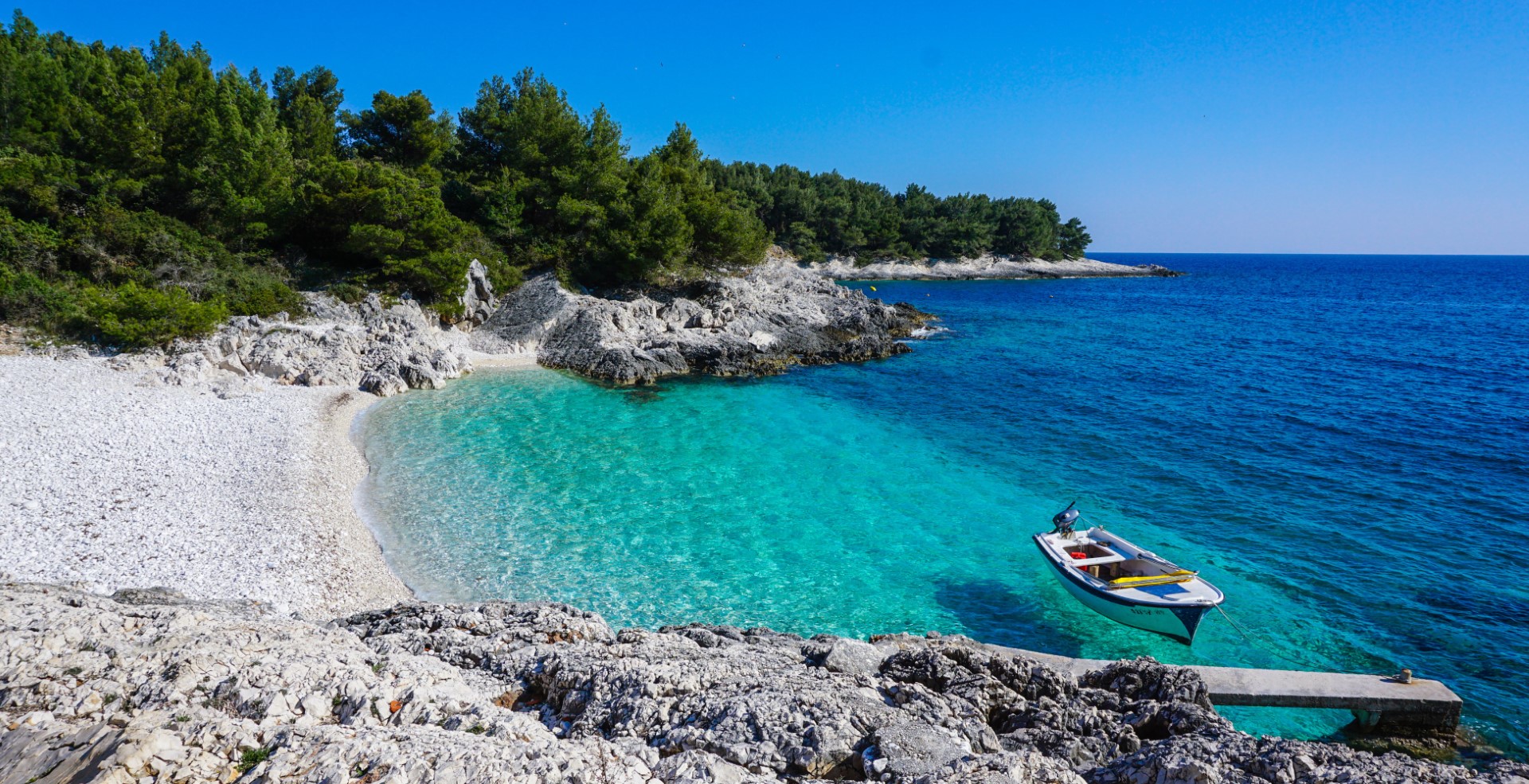
Pokonji dol is an outskirt of Hvar town. There is a paved road leading to it, and in summer time it is a very popular beach. Overlooking a small island with a beautiful lighthouse bearing the same name, this bay hosts a popular local tavern and a bar.
Hvar town is where we will end this part of our adventure. Describing Hvar town, its history and culture is out of scope of this blog. But it is a memorable view to enter it from the sea, as Španjola fortress looks over your arrival to the port of Hvar.
At the end of a big and popular port of Hvar, one small, well protected little port named Mandrač awaits. This is where the locals keep their small boats, and where this photo was taken.
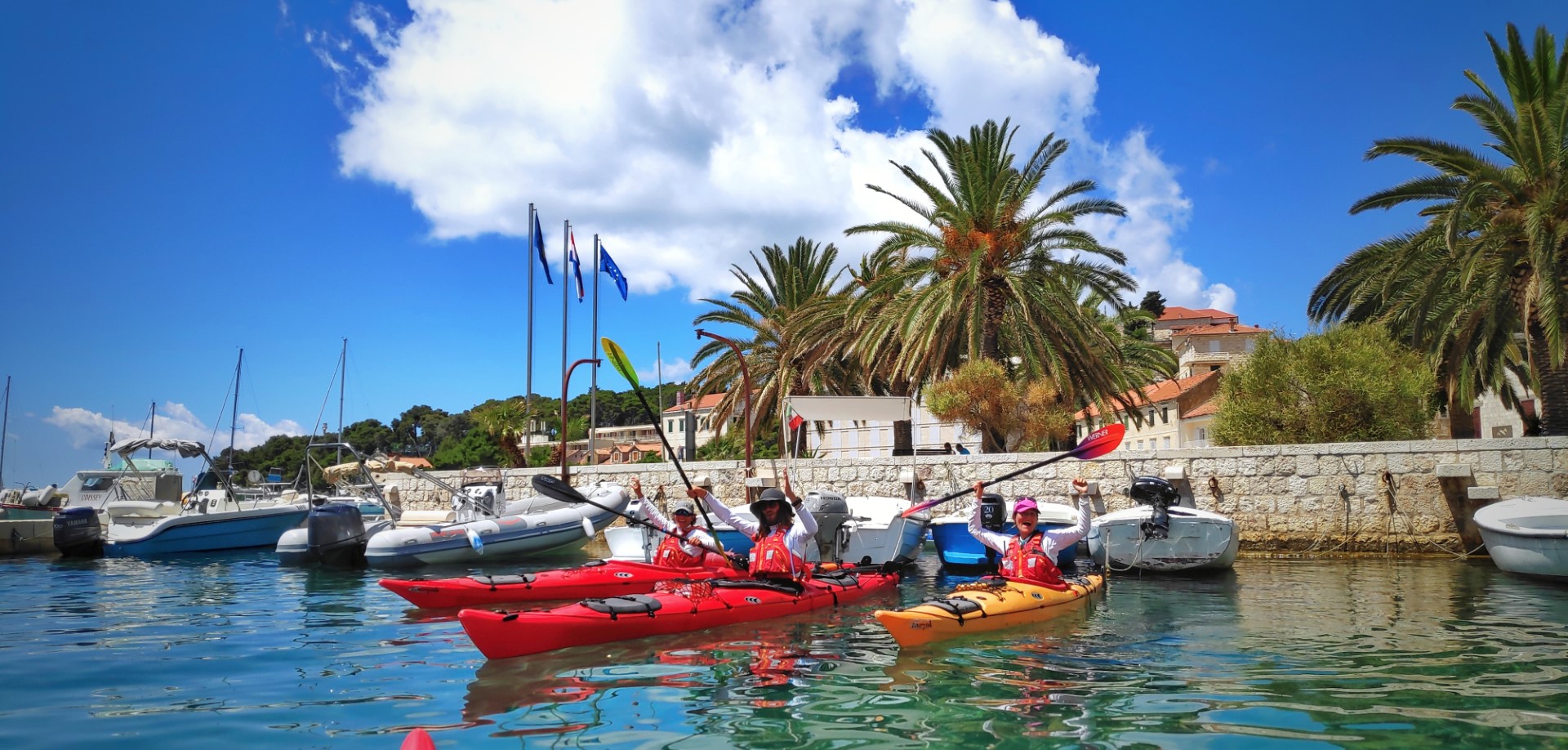
Stay tuned for Part 3 of our adventure. There we’ll discover not so visited area between Hvar and Stari Grad.
We have uploaded photos of all bays on our Facebook page and you can explore the gallery on the following LINK




